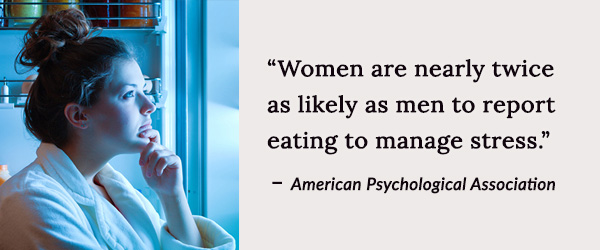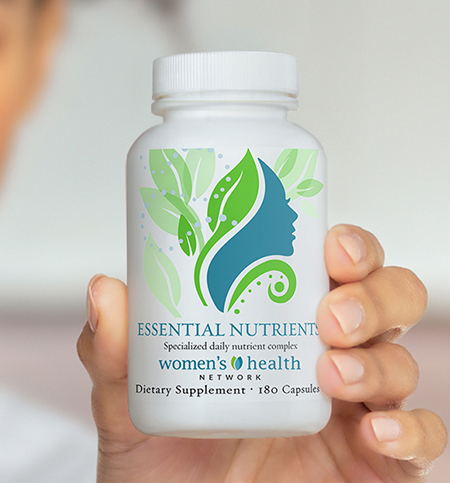Authored by Caroline Morin, NBC-HWC
Healthy eating habits are driven by a person’s hunger cues, but emotional eating is driven by feelings, mood and stress levels. In that emotional headspace, unhealthy ultra-processed foods high in sugar, seed oils and salt can be hard to resist.
Do you need help tuning back into your hunger cues and healthy eating patterns? Here are the surprisingly simple steps you can take to start healing your relationship with food.

Emotional eating is not your fault. Here’s why
Let’s start with an understanding of how emotions and eating can become so entangled in the first place. Our brains are designed to function in predictable patterns. These patterns become hardwired from an early age. As children, we are often offered food as comfort, reward or celebration. Our brain begins to associate these emotional experiences with food. When we feel stress, worry or even boredom, our brains will cue us to crave a particular food to cope with that emotion.
It is typical for people who are emotionally eating to turn to comfort foods, like chips or cookies, or other ultra-processed foods high in sugar, fat and salt. Here’s the reason why: sugar paired with fat and salt activates the part of our brains associated with addiction. Big food companies know this and that’s why they hire chemists, psychologists and engineers to design processed foods that contain these ingredients. Essentially, “Big Food” spends millions of dollars to figure out how to get us to engage in emotional eating!
How can you overcome emotional eating? Try these 10 steps
The relationship between food and emotion is complex. But we can overcome emotional eating by first developing an awareness of the thoughts and feelings that are driving our behavior, and then by learning some healthier coping mechanisms.
Recognize the difference between physical hunger and emotional hunger
Learning to distinguish between physical hunger and emotional “hunger” is a powerful first step in knowing how to address it.
Physical hunger:
- Comes on slowly and can wait
- Can be satiated by a variety of nourishing, nutritious foods
- Comes at expected times of day
- Can stop when full
- You feel satisfied and energized after eating
- It doesn’t trigger a negative emotional response
Emotional hunger:
- Comes on all of a sudden and can’t wait (there’s a feeling of being driven to eat)
- Can only be satisfied by particular foods, generally comfort foods or salt, sugar, fat foods
- Comes on in response to specific stressors, such as a bad day at work
- Can’t stop when full
- Triggers feelings of guilt and shame
Bringing awareness to your eating
People with a high level of emotional awareness are less likely to struggle with emotional eating. Unfortunately, many of us aren’t taught how to identify or process our emotions. Instead, we use food or other coping mechanisms to avoid or repress them.
You can begin to cultivate awareness by simply noticing what’s happening at the moment when you know you’re eating out of emotion, rather than hunger. Instead of being judgmental or beating yourself up over your behavior, simply get curious. What are the circumstances that are going on in the moment? What are you thinking? How do you feel? Stressed? Sad? Lonely? Angry? Bored? Worn out?
Track your food and mood
Tracking your food and mood at regular intervals during the day can deepen your growing emotional awareness and help you understand how your mood impacts your eating patterns. Keep a journal and write down your overall mood and emotion before and after eating, and any physiological feelings you are having (a heavy chest, tightness in your shoulders or jaw, jitteriness) as well as any food cravings you are experiencing. Even after only a short time, you might begin to notice patterns between how you feel and why you are turning to certain foods.
Find some healthy coping mechanisms that do not involve food
Once you’ve become more aware of your feelings, get curious about some ways you might better meet your own needs. You can ask yourself, “How can I cope with this feeling in a healthier way?” Make a list of activities that are quick and easy to manage. They may include phoning a friend, going for a walk, doing some breathwork or making a cup of tea.
This approach was a game-changer for one of my clients struggling with late-night snacking. Initially, Michelle said she honestly had no idea how she was feeling when we explored this step. I asked how she might figure that out and she thought that she might try journaling while she sat down with her late-night snack.
The following week she was elated to report that she figured out that she was eating every night because she was bored. It was a huge relief to her to realize that it wasn’t a matter of willpower, it was a symptom of feeling bored and a little bit lonely. Her children were grown and gone. She was retired from her career as a nurse, and she no longer felt needed. After some exploration, Michelle decided to take up some old hobbies including needlepointing, and to find some volunteer work to give her a better sense of purpose. Michelle’s late-night snacking disappeared almost instantly.
Engineer your environment — inside and out
You may not be able to control your cravings, but it is possible to control some elements of your environment. Not bringing tempting foods in the house or changing your commute home so you don’t drive past your favorite fast food can significantly reduce temptations.
You also want to pay attention to the inner environment of your body. Food cravings can be a prime symptom of hormonal imbalance, especially for women experiencing chronic stress and/or entering perimenopause and menopause. Find out if an overlapping physiological imbalance in your hormones could be intensifying your emotional eating. We have a free quiz to help you do just that! If you have a hormonal imbalance, you can try a natural supplement like our Herbal Equilibrium to restore balance and remove this “inner block” to healthy eating patterns.
Develop a different mindset around food
If you were raised to see food as a reward or treat, you may find you are more likely to experience cravings driven by emotion. To escape these patterns, developing a mindset where you see food as fuel and a source of nourishment can be a powerful step. Eating small meals and snacks throughout the day can help train your brain to understand that good food is always coming — you don’t need to do anything special to deserve it!
Be sure to eat regularly
Another reason to establish a meal and snack schedule? If we let ourselves get to the point that we are over-hungry, we are much more likely to make less nutritious food choices and overeat. Begin to notice your body’s hunger cues. When you get to the point where you’re feeling hungry, have a snack. It can be helpful to have some nutrient-dense snacks on hand.
Hydrate
When we are dehydrated, our bodies aren’t as able to metabolize glycogen for energy. This is why sugar cravings can be a sign of dehydration. Additionally, we can often mistake hunger for thirst. So the next time you’re hit with a craving, try drinking a glass of water and waiting for a few minutes to allow your body to adapt and the craving to pass. Many people find that they have fewer cravings when they have had plenty of water to drink throughout the day.
Swap out the processed foods for more nutrient-dense counterparts
Researchers are finding that the more we resist foods, the more strongly we may experience cravings. This is one reason restricting foods and relying on willpower just doesn’t work. So, if you’re craving a burger, go on and have one. Maybe instead of fast food, you make one at home. If you’re craving something sweet, rather than ice cream, try a greek yogurt with honey or some berries. Make small changes and you’ll likely find your taste buds will adapt over time.
Bonus tip: Filling nutritional gaps with a multivitamin can help make sure you have all the micronutrients on board that you need to fully utilize nutrients in your foods.
What will your story be?
Overcoming emotional eating and achieving healthier habits demands understanding, patience and compassion. Emotional eating isn’t about lacking willpower — it’s a deeply ingrained response molded by our experiences and environment. But developing awareness and then making small but meaningful shifts in mindset and behavior, like finding new coping methods, adjusting our surroundings and fueling our bodies properly, sets us on the path to lasting change. Remember, the journey is gradual, marked by self-discovery, resilience and growth.
Important note about Binge Eating Disorder: Emotional eating can often be a symptom of binge eating disorder, or it may go hand in hand with depression or mood disorder. In these cases, it may be important to seek help from a qualified mental health expert.
References and further reading
Dornelles, Adriana. Impact of multiple food environments on body mass index. 2019.
















